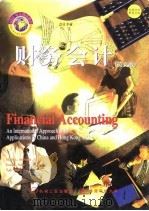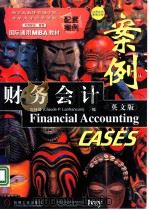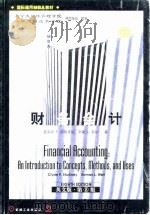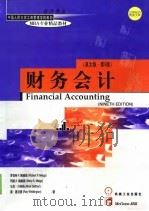《会计学:财务会计分册 英文版》
| 作者 | (美)梅斯(Meigs,R.F.)等著 编者 |
|---|---|
| 出版 | 北京:机械工业出版社 |
| 参考页数 | 673 |
| 出版时间 | 1999(求助前请核对) 目录预览 |
| ISBN号 | 7111073533 — 求助条款 |
| PDF编号 | 81910878(仅供预览,未存储实际文件) |
| 求助格式 | 扫描PDF(若分多册发行,每次仅能受理1册) |

Contents in Brief2
1 Accounting:Information for Decision Making2
1 Accounting:Information for Decision Making2
Table of Contents2
Comprehensive Problem2
Accounting Information:A Means to an End4
Types of Accounting Information5
Accounting from a User s Perspective5
Accounting Systems6
The Cost of Producing Accounting Information7
Determining Information Needs7
Basic Functions of an Accounting System8
Who Designs and Installs Accounting Systems?8
Decision Making by Extemal Parties9
External Users of Accounting Information9
Objectives of External Financial Reporting10
Characteristics of Externally Reported Information13
Decision Making by Internal Parties14
Internal Users of Accounting Information14
Objectives of Management Accounting16
Characteristics of Management Accounting Information17
Integrity of Accounting Information18
Institutional Features19
Professional Organizations21
Competence,Judgment,and Ethical Behavior22
Supplemental Topic:Careers in Accounting25
Public Accounting25
Management Accounting25
Governmental Accounting26
What About Bookkeeping?27
Accounting Education27
Accounting as a Stepping-Stone27
End-of-Chapter Review28
Assignment Material31
2 Basic Financial Statements38
2 Basic Financial Statements38
Introduction to Financial Statements40
A Starting Point:Statement of Financial Position41
Assets43
Liabilities45
Creditors Claims Have Priority Over Those of Owners45
Owner s Equity45
The Accounting Equation46
The Effects of Business Transactions:An Illustration47
the Accounting Equation52
Effects of These Business Transactions on52
Income Statement54
Statement of Cash Flows54
Relationships Among Financial Statements56
Forms of Business Organizations58
Sole Proprietorships58
Parmerships59
Corporations59
Reporting Ownership Equity in the Balance Sheet59
The Use of Financial Statements by Outsiders60
The Need for Adequate Disclosure61
Management s Interest in Financial Statements61
End-of-Chapter Review63
Assignment Material67
3 The Accounting Cycle:Capturing82
Economic Events82
3 The Accounting Cycle:Capturing Economic Events82
The Role of Accounting Records84
The Ledger84
The Use of Accounts84
Debit and Credit Entries85
Double-Entry Accounting—The Equality of Debits andCredits86
Recording Transactions in Ledger Accounts:An87
Illustration87
The Journal90
Posting Journal Entries to the Ledger Accounts(and How to Read a Journal Entry)91
What Is Net Income?93
Revenue95
Expenses96
The Accrual Basis of Accounting97
Investments and Withdrawals by the Owner98
Debit and Credit Rules for Revenue and Expenses98
Recording December s Revenue and Expense99
Transactions:An Illustration99
The Journal104
December s Ledger Balances104
The Accounting Cycle106
The Trial Balance106
Uses and Limitations of the Trial Balance107
Adjusting Entries:The Next Step in the107
Accounting Cycle107
Shop Supplies:An Asset That Turns into an Expense107
The Concept of Depreciation108
Recording Depreciation Expense:An Illustration110
The Adjusted Trial Balance111
Preparing Financial Statements112
The Income Statement112
The Statement of Owner s Equity113
The Balance Sheet113
The Statement of Cash Flows113
Relationship Among the Financial Statements115
Closing the Temporary Equity Accounts115
Closing Entries for Revenue Accounts116
Closing Entries for Expense Accounts116
Closing the Income Summary Account117
Closing the Owner s Drawing Account118
Summary of the Closing Process118
After-Closing Trial Balance119
The Accounting Cycle in Perspective120
Some Concluding Remarks120
End-of-Chapter Review121
Assignment Material127
4 The Accounting Cycle:Preparing an Annual Report142
4 The Accounting Cycle:Preparing142
an Annual Report142
Preparing the Annual Report144
Adjusting Entries:A Closer Look145
The Need for Adjusting Entries145
Types of Adjusting Entries145
Characteristics of Adjusting Entries146
Year-End at Overnight Auto Service148
Apportioning Recorded Costs149
Apportioning Unearned Revenue151
Recording Unrecorded Expenses153
Recording Unrecorded Revenue155
Adjusting Entries and Accounting Principles155
The Concept of Materiality156
Effects of the Adjusting Entries157
Preparing the Statements158
Drafting the Notes That Accompany Financial159
Statements159
What Types of Informaton Must Be Disclosed?161
Closing the Accounts162
A Last Look at Overnight:Was 2002 a Good Year?163
Preparing Financial Statements Covering DifferentPeriods of Time164
Supplemental Topic:The Worksheet166
Isn t This Really a Spreadsheet ?166
What s It Used For?166
The Mechanics:How It s Done166
What If... :A Special Applicarion of WorksheetSoftware169
End-of-Chapter Review170
Assignment Material175
A Comprehensive Accounting Cycle Problem190
Comprehensive Problem 1—Tony s Rentals190
Comprehensive Problem 1:Tony s Rentals190
5 Accounting for Merchandising Activities192
5 Accounting for Merchandising Activities192
Merchandising Companies194
The Operating Cycle of a Merchandising Company194
Income Statement of a Merchandising Company195
What Accrounting Information Does a MerchandisingCompany Need?196
General Ledger Accounts196
Subsidiary Ledgers:A Source of Needed Details196
Two Approaches Used in Accounting for199
Perpetual Inventory Systems199
Merchandising Transactions199
Closing Entries in a Perpetual Inventory System202
Periodic Inventory Systems202
Taking a Physical Inventory202
Operation of a Periodic Inventory System203
Closing Process in a Periodic Inventory System204
Comparison of Perpetual and Periodic204
Inventory Stems204
Selecting an Inventory System205
Modifying an Accounting System206
Special Journals Provide Speed and Efficiency206
Credit Terms and Cash Discounts207
Transactions Relating to Purchases207
Transportation Costs on Purchases209
Returns of Unsatisfactory Merchandise209
Transactions Relating to Sales210
Sales Returns and Allowances210
Sales Discounts211
Delivery Expenses212
Accounting for Sales Taxes212
Evaluating the Performance of a Merchandising212
Company212
Net Sales212
Gross Profit Margins213
Using Information About Profit Margins214
End-of-Chapter Review215
Assignment Material220
6 Forms of Business Organization232
6 Forms of Business Organization232
Sole Proprietorships234
The Concept of the Separate Business Entity234
Characteristics of a Sole Proprietorship234
Unlimited Personal Liability (Subtitle:The OwnerCould Lose EVERYTHING!)235
Accounting Practices of Sole Proprietorships235
Evaluating the Financial Statements of a235
Proprietorship235
Partnerships236
General Partnerships237
Parmerships That Limit Personal Liability238
Accounting Practices of Parmerships239
Evaluating the Financial Statements of a Partnership240
What Is a Corporation?240
Corporations240
Stockholders Liability for Debts of a Corporation241
What Types of Businesses Choose the Corporate242
Form of Organization?242
Accounting for Corporate Income Taxes242
Salaries Paid to Owners244
Owner s Equity in a Corporate Balance Sheet244
Accounting for Dividends245
Retained Earnings245
The Issuance of Capital Stock245
Closing Entries and the Statement of Retained Earnings246
Evaluating the Financial Statements of a Corporation247
The Concept—and the Problem—of Double Taxation248
S Corporations248
Selecting an Appropriate Form of Business249
Organization249
Incorporating an Established Business249
Supplemental Topic:Partnership Accounting—251
A Closer Look251
Opening the Accounts of a New Partnership251
Allocating Partnership Net Income Among the Partners253
End-of-Chapter Review258
Assignment Material262
7 Financial Assets274
7 Financial Assets274
How Much Cash Should a Business Have?276
The Valuation of Financial Assets276
Reporting Cash in the Balance Sheet277
The Statement of Cash Flows277
Cash277
Cash Management278
Internal Control Over Cash279
Cash Disbursements280
Bank Statements281
Reconciling the Bank Statement282
The Cash Budget as a Control Device285
Short-Term Investments285
Petty Cash Funds285
Mark-to-Market:A New Principle of Asset Valuation286
Accounts Receivable287
Uncollectible Accounts288
The Allowance for Doubtful Accounts289
Writing Off an Uncollectible Account Receivable290
Recovery of an Account Receivable Previously291
Written Off291
Manthly Estimates of Credit Losses291
Direct Write-off Method294
Income Tax Regulations and Financial Reporting294
Internal Controls for Receivables294
Management of Accounts Receivable295
Factoring Accounts Receivable295
Credit Card Sales295
Evaluating the Quality of Accounts Receivable296
Notes Receivable and Interest Charges298
Supplemental Topic A:Accounting for MarketableSecurities299
Purchases of Marketable Secutities299
Recognition of Investment Revenue300
Sales of Investments300
Adjusting Marketable Securities to Market Value301
Interest Revenue302
Reporting Investment Transactions in the FinancialStatements302
Supplemental Topic B:Notes Receivable and302
Nature of Interest303
Accounting for Notes Receivable303
The Decision of Whether to Accrue Interest305
End-of-Chapter Review306
Assignment Material311
8 Inventories and the Cost of Goods Sold328
8 Inventories and the Cost of Goods Sold328
Inventory Defined330
The Flow of Inventory Costs330
Which Unit Did We Sell?330
Data for an Illustrution331
Specific Identification332
Cost Flow Assumptions332
Average-Cost Method333
First-In,First-Out Method334
Last-In,First-Out Method334
Evaluation of the Methods335
Do Inventory Methods Really Affect Performance?337
The Principle of Consistency338
Taking a Physical Inventory339
Just-in-Time (JIT) Inventory Systems339
Recording Shrinkage Losses340
LCM and Other Write-Downs of Inventory341
The Year-End Cutoff of Transactions341
Periodic Inventory Systems342
Importance of an Accurate Valuation of Inventory345
Techniques for Estimating the Cost of Goods sold andthe Ending Inventory346
The Gross Profit Method347
The Retail Method347
Textbook Inventory Systems Can Be Modified...and They Often Are348
Evaluating the Liquidity of Inventory349
Inventory Turnover Rate349
Accounting Methods Can Affect Analytical Ratios350
Supplemental Topic:LIFO Reserves351
The Significance of a LIFO Reserve352
End-of-Chapter Review354
Assignment Material358
Guitar Universe,Inc.374
Comprehensive Problem 2—Guitar Universe,Inc.374
9 Plant Assets and Depreciation376
9 Plant Assets and Depreciation376
Plant Assets as a Stream of Future Services378
Major Categories of Plant Assets378
Accountable Events in the Lives of Plant Assets378
Acquisitions of Plant Assets378
Determining Cost:An Example379
Some Special Considerations379
Capital Expenditures and Revenue Expenditures380
Allocating the Cost of Plant and Equipment overthe Years of Use381
Depreciation381
Causes of Depreciation382
Methods of Computing Depreciation383
The Straight-Line Method384
The Declining-Balance Method386
MACRS:The Tax Method387
Which Depreciation Methods Do Most389
Businesses Use?389
Financial Statement Disclosures391
The Impairment of Plant Assets392
Disposal of Plant and Equipment392
Equipment393
Gains and Losses on Disposals of Plant and393
Gains and Losses for Income Tax Purposes394
Which Amounts Are Recorded in the Accounting395
Records?395
Trading in Used Assets for New Ones396
Characteristics397
Operating Expenses Versus Intangible Assets397
Intangible Assets397
Other Income Tax Reporting Obligations397
Amortization398
Goodwill398
Patents400
Trademarks and Trade Names401
Franchises401
Copyrights401
Other Intangibles and Deferred Charges401
Research and Development(R D) Costs401
Natural Resources402
Accounting for Natural Resources402
A Common Goal403
Depreciation,Amortization,and Depletion—403
Plant Transactions and the Statement of Cash Flows403
The Units-of-Output Method404
Supplemental Topic:Other Depreciation Methods404
MACRS405
Sum-of-the-Years Digits405
Decelerated Depreciation Methods405
Depreciation Methods in Use:A Survey405
End-of-Chapter Review407
Assignment Material411
10 Liabilities424
10 Liabilities424
The Nature of Liabilities426
Accounts Payable427
Notes Payable427
Current Liabilities427
The Current Portion of Long-Term Debt428
Accrued Liabilities429
Payroll Liabilities429
Unearned Revenue430
Long-Term Liabilities430
Maturing Obligations Intended to Be Refinanced430
Installment Notes Payable431
Special Types of Liabilities433
Bonds Payable433
What Are Bonds?434
Tax Advantage of Band Financing436
Accounting for Bonds payable436
The Concept of Present Value438
Bond Prices After Issuance439
Early Retirement of Bonds Payable440
Capital Leases441
Lease Payment Obligations441
Operating Leases441
Liabilities for Pensions and Other PostretirementBenefits442
Deferred Income Taxes445
Liabilities and Cash Flows446
Evaluating the Safety of Creditors Claims447
How Much Debt Should a Business Have?448
Supplemental Topic A:Estimated Liabilities,Loss450
Estimated Liabilities450
Loss Contingencies450
Contingencies,and Commitments450
Commitments452
Supplemental Topic B:Bonds Issued at a Discount452
or a Premium452
Accounting for Bond Discount:An Illastration452
Accounting for Bond Premium454
Bond Discount and Premium in Perspective454
End-of-Chapter Review455
Assignment Material460
11 Stockholders Equity:Paid-in Capital474
11 Stockholders Equity:Paid-in Capital474
Corporations476
Why Businesses Incorporate476
Publicly Owned Corporations478
Formation of a Corporation478
Stockholder Records in a Corporation481
Paid-in Capital of a Corporation482
Authorization and Issuance of Capital Stock483
Common Stocks and Preferred Stocks484
Characteristics of Preferred Stock485
Subscriptions to Capital Stock488
Stock Issued for Assets Other Than Cash488
Donated Capital489
Book Value per Share of Common Stock489
Market Value490
Market Price of Preferred Stock491
Market Price of Common Stock492
Book Value and Market Price493
Stock Splits493
Treasury Stock494
Recording Purchases of Treasury Stock494
Reissuance of Treasiru Stock495
Stock Buyback Programs496
End-of-Chapter Review498
Assignment Material502
12 Income and Changes in Retained Earnings512
12 Income and Changes in Retained Earnings512
Reposing the Results of Operations514
Developing Predictive Information514
Reporting Irregular Items:An Illustration514
Continuing Operations515
Discontinued Operations515
Extraordinary Items516
Changes in Accounting Principles519
Earnings per Share (EPS)520
Basic and Diluted Earnings per Share522
Divideut Dates524
Cash Dividends524
Other Transactions Affecting Retained Earnings524
Liquidating Dividends525
Stock Dividends526
Statement of Retained Earnings528
Prior Period Adjustments529
Comprehensive Income530
Statement of Stockholders Equity531
Stockholders Equity Section of the Balance Sheet532
End-of-Chapter Review533
Assignment Material538
13 Statement of Cash Flows552
13 Statement of Cash Flows552
Statement of Cash Flows554
Example of a Statement of Cash Flows554
Purpose of the Statement554
Classification of Cash Flows555
Critical Importance of Cash Flows from OperatingActivities557
The Approach to Preparing a Statement of557
Cash Flows557
An Illustration558
Preparing a Statement of Cash Flows:558
Investing Activities559
Operating Activities559
Financing Activities561
Cash and Cash Equivalents561
Cash Flows from Operating Activities561
Cash Payments for Merchandise and for Expenses563
Differences Between Net Income and Net Cash566
Flows from Operating Activities566
Reporting Operating Cash Flows:The Direct566
and Indirect Methods566
Cash Flows from Investing Activities567
Cash Flows from Financing Activities568
Relationship Between the Statement of Cash Flowsand the Balance Sheet569
The Statement of Cash Flows:A Second Look570
Using the Statement of Cash Flows570
What Priority Should Managers Give to IncreasingNet Cash Flows?572
Budgeting:The Primary Cash Management Tool572
Managing Cash Flows572
Industries Incorporated572
Annotated Statement of Cash Flows:ABM572
Some Strategies for Permanent Improvements in574
Cash Flow574
Concluding Comments...576
Supplemental Topic A:The Indirect Method577
Comparison of the Direct and Indirect Methods577
Differences Between Net Income and Net Cash Flowsfrom Operating Activities578
Reconciling Net Income with Net Cash Flows578
The Indirect Method:A Summary580
Indirect Method May Be Required in580
a Supplementary Schedule580
Supplemental Topic B:A Worksheet for Preparing581
a Statement of Cash Flows581
Data for an Illustration581
The Worksheet582
Entry582
End-of-Chapter Review586
Assignment Material592
14 Financial Statement Analysis608
14 Financial Statement Analysis608
Financial Statements Are Designed for Analysis610
Tools of Analysis611
Dollar and Percentage Changes611
Trend Percentages612
Component Percentages613
Ratios614
Standards of Comparison614
Quality of Earnings615
Quality of Assets and the Relative Amount of Debt616
Impact of Inflation616
Measures of Liquidity and Credit Risk616
A Classified Balance Sheet616
Working Capital618
Current Ratio619
Quick Ratio619
Debt Ratio620
Evaluating Financial Ratios620
Concluding Comment—Solvency Credit Risk,622
and the Law622
Measures of Profitability623
Classifications in the Income Statement623
Some Specific Examples of Corporate Earnings623
and Losses623
Multiple-Step Income Statements624
Price-Earnings Ratio627
Earnings per Share627
Single-Step Income Statements628
Evaluating the Adequacy of Net Income629
Return on Investment(ROI)629
Return on Assets(ROA)629
Return on Equity(ROE)630
Comprehensive Illustration:Seacliff Company631
Analysis by Common Stockholders634
Return on Investmens(ROI)636
Leverage637
Analysis by Long-Term Creditors638
Analysis by Short-Term Creditors639
Cash Flow Anatysis642
Usefulness of Notes to Financial Statements643
Some Concluding Comments644
Sources of Financial Information644
Financial Analysis and Stock Price644
Summary of Analytical Measurements645
End-of-Chapter Review647
Assignment Material652
a Publicly Owned Corporation671
Part Ⅰ671
Comprehensive Problem 3—Toys R Us,Inc.671
Analysis of the Financial Statements of671
Comprehensive Problem 3 Toys R Us,Inc.671
Possible Credit Rating672
Part Ⅲ672
Part Ⅱ672
15 Global Business and Accounting674
15 Global Business and Accounting674
Globalization676
Environmental Forces Shaping Globalization678
Political and Legal Systems678
Economic Systems680
Culture681
Technology and Infrastructure683
Foreign Currencies and Exchange Rates685
Exchange Rates685
Accounting for Transactions with Foreign Companies686
Currency Fluctuations—Who Wins and Who Loses?690
Consolidated Financial Statements That IncludeForeign Subsidiaries691
Global Sourcing691
Foreign Corrupt Practices Act693
End-of-Chapter Review695
Assignment Material699
16 Management Accounting:A Business Partner708
16 Management Accounting:708
A Business Partner708
Management Accounting:Basic Framework710
Management Accounting s Role in Assigning710
Decision-Making Authority710
Management Accounting s Role in Decision Making710
Management Accounting s Role in Performance711
Evaluation and Rewards711
Accounting Systems:A Business Partner712
Accounting for Manufacturing Operations713
Classifications of Manufacturing Costs713
Product Costs Versus Period Costs713
Product Costs and the Matching Principle715
Inventories of a Manufacturing Business715
The Flow of Costs Parallels the Flow of PhysicalGoods716
Accounting for Manufacturing Costs:An Illustration716
Direct Materials717
Direct Labor718
Manufacturing Overhead718
Overhead Application Rates720
Direct and Indirect Manufacturing Costs720
What Drives Overhead Costs?722
Workin Process Inventory,Finished Goods Inventory,and the Cost of Goods Sold723
The Need for Per-Unit Cost Data724
Determining the Cost of Finished Goods Manufactured724
Financial Statements of a Manufacturing Company725
End-of-Chapter Review727
Assignment Material730
17 Accounting Systems for Measuring Costs746
17 Accounting Systems for Measuring Costs746
Cost Accounting Systems748
Basic Cost Accounting Methods749
Job Order Costing750
The Job Cost Sheet750
Accounting for Direct Materials751
Flow of Costs in Job Costing:An Illustration751
Accounting for Direct Labor Costs752
Accounting for Overhead Costs752
Accounting for Completed Jobs753
Job Order Costing in Service Industries755
Process Costing756
Work in Process Account—The Key to Process Costing756
Process Costing and Equivalent Units757
Cost per Equivalent Unit759
Flow of Costs in Process Costing:An Illustration761
Computing and Using Unit Costs762
Evalua tingDepartmental Efficiency763
Activity-Based Costing(ABC)763
ABC Versus a Single Application Rate:A Comparison764
Determining Unit Costs Using ABC770
The Trend Toward More Informative Cost771
Accounting Systems771
End-of-Chapter Review773
Assignment Material779
18 Costing and the Value Chain792
18 Costing and the Value Chain792
The Value Chain794
Value-and Non-Value-Added Activities794
Activity-Based Management795
Activity-Based Management Across the Value Chain796
ABC:A Subset of Activity-Based Management798
The Target Costing Process798
Components of the Target Costing Process799
Target Costing:An Illustration800
Characteristics of the Target Costing Process803
Just-in-Time Inventory Procedures803
JIT,Supplier Relationships,and Product Quality804
Measures of Efficiency in a JIT System805
A Concluding Comment805
Total Quality Management and the Value Chain806
Components of the Cost of Quality806
Measuring the Cost of Quality808
Productivity and Quality809
Managing Across the Value Chain809
End-of-Chapter Review810
Assignment Material814
19 Cost-Volume-Profit Analysis824
19 Cost-Volume-Profit Analysis824
Cost-Volume Relationships826
Cost-Volume Relationships:A Graphic Analysis827
The Behavior of Per-Unit Costs829
Economies of Scale830
Additional Cost Behavior patterns831
Cost Behavior and Operating Income832
Cost-Volume-Profit Analysis:An Illustration833
Preparing and Using a Cost-Volume-Profit Graph833
Contribution Margin:A Key Relationship835
How Many Dollars in Sales Must We Generate?836
How Many Units Must We Sell?836
What Is Our Margin of Safety?837
What Change in Operating Income Do We Anticipate?837
Business Applications of CVP837
Additional Considerations in CVP840
CVP Analysis When a Company Sells Many Products840
Determining Semivariable Cost Elements:841
The High-Low Method841
Assumptions Underlying Cost-Volume-Profit Analysis842
Sunmary of Basic Cost-Volume-Profit Relationships842
End-of-Chapter Review844
Assignment Material847
20 Incremental Analysis860
20 Incremental Analysis860
The Challenge of Changing Markets862
The Concept of Relevant Cost Information862
Relevant Information in Business Decisions863
Opportunity Costs864
Sunk Costs Versus Out-of-Pocket Costs864
Incremental Analysis in Common Business865
Decisions865
Special Order Decisions865
Production Constraint Decisions867
Make or Buy Decisions868
Sell,Scrap,or Rebuild Decisions870
Joint Product Decisions871
Concluding Comments872
End-of-Chapter Review874
Assignment Material877
Comprehensive Problem 4—Gilster Company887
Comprehensive Problem 4 The Gilster887
Company887
21 Responsibility Accounting and Performance890
Evaluation890
21 Responsibility Accounting and Performance Evaluation890
Responsibility Centers892
The Need for Information About Responsibility CenterPerformance892
Cost Centers,Profit Centers,and Investment Centers892
Responsibility Accounting Systems896
Responsibility Accounting:An Illustration896
Assigning Revenue and Costs to Business Centers896
Vorioble Costs898
Contribution Margin898
Fixed Costs898
Traceable Fixed Costs899
Common Fixed Costs899
Responsibility Margin900
When Is a Responsibility Center Unprofitable ?902
Evaluating Responsibility Center Managers902
Arguments Against Allocating Common Fixed Costs toBusiness Centers903
Transfer Prices903
Nonfinancial Objectives and Information905
Business Center Reporting in Financial Statements906
Supplemental Topic:Variable Costing907
Full Costing:The Traditional View of Product Costs907
Variable Costing:A Different View of Product Costs908
An Illustration of Variable Costing908
Fluctuation in the Level of Production911
Why Is Variable Costing Unacceptable for Use in914
Financial Statements and Income Tax Returns?914
End-of-Chapter Review915
Assignment Material918
22 Operational Budgeting930
22 Operational Budgeting930
Profit Rich,Yet Cash Poor932
Operating Cash Flows:The Lifeblood of Survival933
Budgeting:The Basis for Planning and Control934
Benefits Derived from Budgeting934
Establishing Budgeted Amounts935
The Budget Period935
The Master Budget:A Package of Related Budgets936
Steps in Preparing a Master Budget937
Preparing the Master Budget:An Illustration938
Operating Budget Estimates938
Budgeted Income Statement942
Financial Budget Estimates943
The Cash Budget948
Budgeted Balance Sheets948
Using Budgets Effectively948
Flexible Budgeting950
End-of-Chapter Review953
Assignment Material956
23 Standard Cost Systems968
23 Standard Cost Systems968
Establishing and Revising Standard Costs970
Standard Cost Systems970
Direct Material Standards971
Direct Labor Standards971
Manufacturing Overhead Standards971
Standard Costs and Variance Analysis:An Illustration972
Materials Price and Quantity Variances973
Labor Rate and Efficiency Variances975
Manufacturing Overhead Variances976
Valuation of Finished Goods979
Evaluating Cost Variances from Different Perspectives979
In Conclusion...981
A Final Note:JIT Systems and Variance Analysis982
End-of-Chapter Review983
Assignment Material986
Comprehensive Problem 5—Utease Corporation1000
Comprehensive Problem 5 Utease Corporation1000
24 Capital Budgeting1002
24 Capital Budgeting1002
Capital Investment Decisions1004
Financial and Nonfinancial Considerations1004
An Illustration1005
Evaluating Capital Investment Proposals:1005
Payback Period1006
Return on Average Investment1006
Discounting Future Cash Flows1007
Replacing Assets1010
Behavioral Considerations in Capital Budgeting1012
In Summary...1013
A Concluding Comment from the Authors1013
End-of-Chapter Review1014
Assignment Material1017
Appendix A Toys R Us Annual Report1029
APPENDIX A Annual Report of Toys R Us1029
APPENDIX B Exploring the Internet1056
Getting Started1056
Appendix B Exploring The Internet1056
Use of the Intemet in This Textbook1056
Internet Assignment Materials1057
The Concept1070
Amounts and Present Values1070
Relationships Between Present Values and FutureAmounts1070
APPENDIX C The Time Value of Money:Future1070
Appendix C The Time Value of Money:Future Amounts and Present Values1070
Compound Interest1071
Future Amounts1072
The Tables Approach1072
Applications of the Tune Value of Money Concept1072
The Future Amount of an Annuity1074
Interest Periods of Less Than One Year1075
Present Values1076
Using Present Value Tables1077
What Is the Appropriate Discount Rate?1077
The Present Value of an Annuity1078
Discount Periods of Less Than One Year1079
Interest-Bearing Receivables and Payables1080
Non-Interest-Bearing Notes1080
Valuation of Financial Instmments1080
Market Prices of Bonds1082
Capital Leases1082
Obligations for Postretirement Benefits1083
Deferred Income Taxes1084
Capital Budgeting:Another Application of PresentValue1084
Disclosure of Up-to-Date Present Value Information1084
Assignment Material1085
Index1089
1999《会计学:财务会计分册 英文版》由于是年代较久的资料都绝版了,几乎不可能购买到实物。如果大家为了学习确实需要,可向博主求助其电子版PDF文件(由(美)梅斯(Meigs,R.F.)等著 1999 北京:机械工业出版社 出版的版本) 。对合法合规的求助,我会当即受理并将下载地址发送给你。
高度相关资料
-

- 财务会计 英文版 第9版
- 1998 北京:机械工业出版社
-

- 财务会计学
- 1989年01月第1版
-

- 财务会计案例:英文版
- 1998年07月第1版
-

- 财务会计:英文版·第8版
- 1998年07月第1版 机械工业出版社
-

- 农业学大寨-山东省农业学大寨会议典型材料 1
- 1976 济南:山东人民出版社
-

- 财务会计 英文版 第4版
- 1998 沈阳:东北财经大学出版社
-

- 财务会计学
- 1996 北京:中国商业出版社
-

- 财务会计 英文版 第8版
- 1998 北京:机械工业出版社
-

- 财务会计学
- 1996 北京:中国农业科技出版社
-

- 公司财务会计 英文版 第5版
- 1998 沈阳市:东北财经大学出版社
-

- 医院质量管理规范
- 1992 南宁:广西民族出版社
-

- 财务会计 英文版 第9版
- 1998 北京:机械工业出版社
-

- 财务会计学
- 1995 沈阳:辽宁人民出版社
-

- 财务会计学
- 1995 哈尔滨:黑龙江科学技术出版社
-

- 财务会计学
- 1995 济南:山东大学出版社
提示:百度云已更名为百度网盘(百度盘),天翼云盘、微盘下载地址……暂未提供。➥ PDF文字可复制化或转WORD